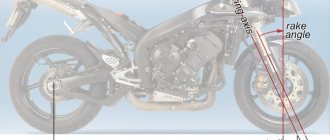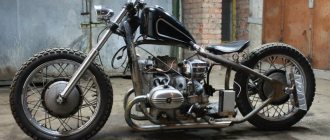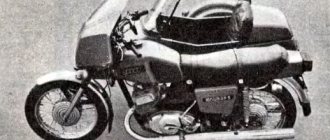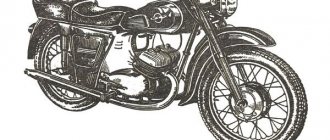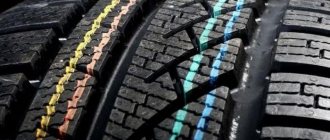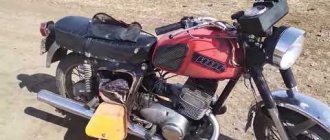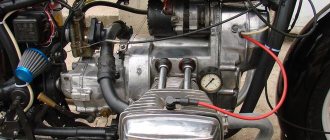Izha fork: design and disassembly
Vehicles of five models and modifications roll off the IZHMASH production line: IZH 7.107 (Planet-5), IZH 7.108 (Planet-5K), IZH 6.113-01 (Jupiter-5-01), IZH 6.114-01 (“Jupiter 5-01K”) and IZH 7.107-015 (“Planet-5-015”).
the motorcycle in the so-called “fifteenth configuration” is equipped with a new front fork, cast wheels and a hydraulically driven front wheel disc brake: three units manufactured under license from Japan. This, in fact, is the difference between the IZH 7.107-015 motorcycle and the regular IZH 7.107.
In this article we will consider only one component - the front suspension. Deputy Chief Designer V. RUDENKO talks about it.
Rice. 1. Installation of the front fork: 1,2 - casing; 3 - bolt; 4 - nut; 5 — washer; 6 — steering column lock washer; 7 — nut M26 X 1.5; 8 — upper bridge; 9 — cap; 10 — protective washer; 11 — ball bearing; 12 — head part of the frame; 13 — special ring; 14 - gasket; 15 — lower bridge; 16 — steering column axis; 17, 18 — shock absorber strut.
The front fork, as usual, consists of guide devices. elastic elements and vibration dampers. The guide devices ensure the specified movement of the wheels relative to the frame and transmit movement resistance forces and braking forces to it. Elastic elements perceive and soften impacts transmitted through the wheels to the sprung parts. Damping devices reduce the time of forced oscillations and turn these oscillations into damped ones.
Motorcycle front suspensions are usually made in the form of telescopic and lever forks. Telescopic forks are the most widespread - they are found on all IZh models. The licensed fork we are considering also belongs to this type.
It is based on two struts 17 (left) and 18 (right) of shock absorbers (Fig. 1), fixedly fixed in the upper 8 and lower 15 bridges, which, using the steering column axis 16 and two ball bearings 11, are pivotally connected to the head part of the frame 12 This device allows you to rotate the fork (and with it the front wheel) relative to the frame, changing the direction of movement. Shock absorber struts are stationary elements of guide devices. Each rack is secured in the upper and lower bridges with bolts 3 and nuts 4. In the areas between the bridges, the racks are covered with casings 1 and 2. The headlight is fixed to the brackets of the casings.
The working part of a fixed pipe is called a cylinder. The outer, movable part of the fork leg slides along it, having a reservoir 22, a piston 21 with a ring 18 and a rebound spring 19. Inside the fixed pipe there are a large 8 and a small 12 spring. The tightness of the connection between the movable and stationary parts of the feather is ensured by a sealing unit, which consists of two cuffs 15, a retaining ring 17 and a protective cover 13, secured to the movable pipe with a clamp 14 and on the non-moving pipe with a clamp 10.
The role of the elastic element in each rack is performed by the already mentioned large and small springs, which have different stiffnesses; this provides the necessary nonlinearity of the suspension characteristics.
In addition, compressed air is used as an elastic element in the suspension under consideration: it is pumped into each airfoil through spools 2. This is the first time this solution has been used on our motorcycles - and therefore we pay special attention to this!
In order for the feathers to work equally, you need to strive to ensure that the pressure in the left and right feathers is as equal as possible. At least the difference should not exceed 0.1 kg/cm2.
If the motorcycle is used by only one driver and his build is not very different from the average, the pressure in the seats should be maintained at approximately 0.2 kg/cm3; if he travels with a passenger - 0.4 kgcm3; and when driving with a stroller - 0.6 kg/cm3. These are, of course, only approximate values. Each driver will very soon set the optimal ones for himself, based on specific conditions. The new struts are much stiffer than the old ones, since the outer diameter of the 20 cylinders has been increased to 38 mm. In addition, the suspension has an unprecedentedly long travel - up to 200 mm. And all this together allows us to say that the new front fork has significantly increased the comfort and safety of riding a motorcycle.
A few words about the vibration damper.
Extinguishing occurs due to the resistance forces that arise when the oil is throttled through a special valve device rolled in the lower part of the working cylinder 20, and also due to the slow flow of the same liquid through the annular gaps between the piston 21 and the inner walls of the cylinder 20 and through the holes in the piston .
Rice. 2. Shock absorber strut: 1 — cap; 2 - spool; 3 - cover; 4 - nut; 5 — small o-ring; 6 — large sealing ring; 7 — upper cup; 8 — large front suspension spring; 9 — valve nut; 10, 14 — clamp; 11, 16 — bushing; 12 — front suspension spring small; 13 — cover; 15 - cuff; 17 — retaining ring; 18 — piston ring; 19 — rebound spring; 20 — working cylinder with valve; 21 - piston; 22 — tank cylinder; 23 - tip; 24 — sealing washer; 25 — screw M10x1.25; 26 — axle holder; 27 — washer; 28 — M6 nut; 29 — M6 pin.
In conclusion, I would like to give some tips regarding the operation and repair of a new fork.
Practice has shown that the fork works quite stably, there are no major complaints about it. However, you need to ensure that the threaded connections are securely tightened, prevent fluid leakage, and systematically check the pressure in the pneumatic pumping system. Pay attention to the safety of protective covers. If you discover any malfunction, try to fix it as soon as possible, without delaying it until later: otherwise, a minor malfunction will certainly turn into a major one.
Since motorcyclists do not have to rely on service, here are some tips for servicing a new suspension.
I recommend replacing the hydraulic fluid for the first time after 2500 km - that is, immediately after the end of the break-in. This should not be neglected, since oil is not just a working fluid, but also a lubricant for the pen parts. If it is contaminated - and during the break-in period this process is especially active - the oil will contribute to increased wear of rubbing parts.
The next oil change should be made after 6-7 thousand kilometers, using 300 cm of MGP-10 fluid (OST 38.1.54-74) for each feather. Unfortunately, replacement can only be done when the stand is removed - this is not entirely convenient for the consumer. However, if you consider that the annual mileage of a motorcycle rarely exceeds 10 thousand km, then this operation, performed at the beginning and end of the season, will not seem so burdensome.
To remove and disassemble the rack, the following sequence of actions is recommended.
Place the motorcycle on a stand and remove the front wheel. Disconnect the front disc brake caliper from the movable pipe. Remove the front fender together with the stamped bridge by unscrewing the bolts securing it to the bosses of the left and right movable pipes.
Remove the caps 3 from each stand (Fig. 2). By pressing spool valves 2, remove air from the upper cavity of the shock absorbers. Unscrew the nuts of the 4 working cylinders halfway. Loosen the coupling bolts in the lower and upper bridges, then knock the struts out of the bridges using a wooden spacer with light hammer blows on nuts 4 and remove them from the motorcycle.
To change the oil, all you have to do is unscrew nut 4 completely, remove large spring 8, bushing 11 and small spring 12 from the pipe. Be careful when you finally unscrew nut 4: springs press on it from below and it can “shoot”. Turn the rack over and drain the oil. Rinse the cylinder with clean unleaded gasoline and blow dry with compressed air.
Assemble the racks and install them on the motorcycle in the reverse order.
If it becomes necessary to replace seal 15, the rack should be completely disassembled. After draining the oil, remove the protective cover 13, unscrew the screw 25 and remove the cylinder 20 along with the piston 21 from the reservoir 22. By removing the retaining ring 17, you will be able to remove the cuffs 15 and replace them with new ones. To prevent oil leakage in the lower part of the rack before tightening screw 25, it is recommended to lubricate its threads with a thin layer of UNIGERM-6 sealant.
Deputy Chief Designer V. RUDENKO
MY MOTORCYCLE
The precise operation of the front fork determines such qualities of the motorcycle as a smooth ride, ease of control, stability and, to a large extent, the service life of the entire machine as a whole. Therefore, to ensure normal operation of the front fork, it is necessary to carry out timely and competent maintenance and follow the basic rules for operating this unit. I think everyone understands that the service life of the suspension depends not only on the road conditions in which the motorcycle is operated, but also on how it is maintained. The service life of the front fork when used in rural areas (mainly on bad roads) ranges from 18,000 to 50,000 km. To many IZh owners, the figure of 50,000 will seem greatly overestimated. But this is true.
How to properly use a fork so that it lasts longer?
After purchasing a new motorcycle, the first thing you need to do is check the correct assembly of the fork: unscrew the nuts of the supporting pipes, install the lock nuts on the rods in the lower position, then screw the plug nuts onto the rods until they stop and secure them in this position with the lock nuts. The thing is. that if the retaining rings and pistons jump off the supporting pipes during the reverse stroke of the suspension, the shock absorber valves may hit the strut covers. With the same length of rods, both valves will experience the impact at the same time and, of course, the lower nuts will be less likely to break off. Next, the correct installation of the racks in the bases of the sliding pipes is checked. For this operation, you need to remove the front wheel and loosen the bolts securing the struts so much that they can turn when the plug nuts rotate along with the rods. Then, by touch, align the pins in the bases of the racks with the corresponding recesses in the movable pipes and tighten the bolts. This must be done to ensure that the racks are in the correct positions. Otherwise, due to distortions, the rod and strut caps will wear out intensively and after a maximum of 4000 km the fork will begin to “knock”.
It doesn’t hurt to check the position of the supporting pipes relative to the upper bridge: they should be at the same level - 1 ... 2 mm below the upper surface of the bridge. We do not recommend over-tightening the nuts of the tie bolts of the lower bridge because the bridge, as a rule, is destroyed not due to the shock load that occurs during driving, but due to excessive tightening of these bolts. The nuts of the sliding pipe seals, of course, also need to be tightened, both with the same force. As a shock absorber fluid, you can fill this fork with regular M8B1 motor oil (in the summer, of course), or something similar, in an amount of 200 cm3/cc per each stay. The oil change in a new fork should be done after the first 500 km, the next after 1500 km, and then every 2000 km. If there are no drain plugs in the sliding pipes, the oil must be drained by removing the wheel and loosening the bolts securing the shock absorber struts. You should not disassemble the fork to change the oil - after all, it is known that each disassembly reduces the life of the unit. The service life of the front fork on a motorcycle with a sidecar largely depends on the correct installation of the sidecar (camber and toe). The front wheel guard is also important in this sense: an unsprung wing adds rigidity to the fork because it serves as an additional bridge. These, in fact, are all the secrets of servicing the front fork during operation. If you don't follow the suggestions. It’s not at all difficult to follow the recommendations; no one can guarantee that the front suspension will last ... 10,000 km. Of course, nothing lasts forever, and fork parts wear out in accordance with the kilometers traveled, and from here it follows. that the condition of this most important unit requires an eye and an eye. For example, it happens that after filling the feathers with oil (175 cm/cube - according to the instructions), after 1000 km a knock appears during the reverse stroke. Most often this does not indicate a malfunction. To check, you should try draining the oil from the feathers and filling them with fresh oil in an amount of 200 cm/cube per feather. The knocking usually disappears. Unexpected oil leakage from under the sliding pipe oil seal nut also occurs. In such a situation, you just need to wipe off the drip. Another depot if oil leaks constantly (usually this happens after a mileage of 15-20 thousand km). The first thing that can be suggested in the event of such a malfunction is to reduce the internal diameter of the textolite guide bushing (if the oil seal is not to blame). One way is to saw the bushing lengthwise and wrap it with a strip of tin to restore the outer diameter. At the same time, you can rotate the supporting pipes around their axes by 90″ to change the wear surface. If the oil leak still continues, you need to replace the oil seal or install a suitable rubber ring under it, but do not tighten the oil seal nut too much. After a run of 40,000 km, it is advisable to change the pistons of the supporting pipes (especially if radial play appears in the feathers).
Such a common malfunction as a fork knocking during reverse stroke on motorcycles with a significant mileage is most often a consequence of rod wear and an enlargement of the hole in the strut cover (let’s not talk about the lack of oil or its insufficient viscosity). In this case, you need to remove the posts from the stays, remove the covers from them and reduce the holes for the rods. This can be done in a variety of ways: surfacing, soldering, seating (flattening, which reduces the thickness of the nut wall around the hole), and installing bushings in the holes. The same result can be achieved by making rods of larger diameter in the middle part. Shrunk springs can be repaired (by analogy with car springs) using a chisel clamped in a vice and a hammer. The length of the spring in the free state will increase, and its relative stiffness will increase accordingly. The length of both springs after such treatment should be the same, at least this should be achieved. It should also be noted that the physical wear of the spring on the inner surface of the supporting pipe is not uniform along its length, so it is not worth straightening it in the most worn places. In these areas, the spring is already weakened, and straightening can cause additional changes in the structure of the metal, which can lead to failure.
Some “craftsmen” try to restore springs by simply stretching them. There is no point in doing this. Since the spring is stretched in areas with pronounced wear, the consequences are obvious. But to make the wear of the spring more uniform, it can be turned 180 (“upside down”) every 10,000 km. But if the fork has served more than 40,000 km, it deserves more attention; for example, sliding and support pipes may need to be replaced. It is clear that only the owner of the motorcycle can decide on the need for serious repairs. But everyone operates and repairs their iron horse as they wish. But I hope this article will still be useful to owners of IZH motorcycles. Take care of your equipment and it will last longer....
